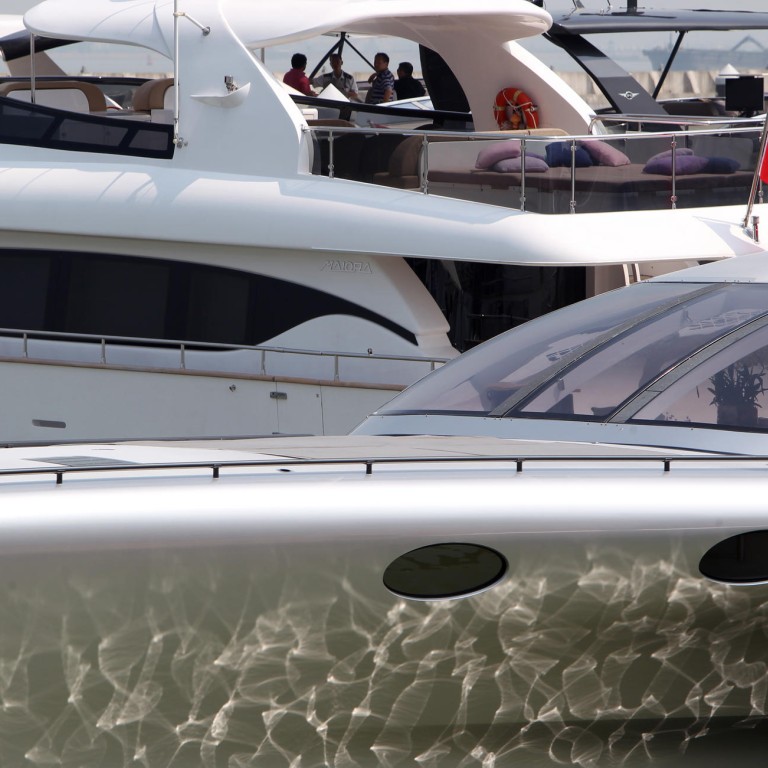
Pushing the boat out
If you want to sell a yacht in the mainland, take out its spare bedroom and put in a jumbo karaoke parlour, writes Denise Tsang
As a Russian general once said, quantity has a quality all its own. That aphorism might be used to describe the impact of the monster boats on display last month at the Nansha Marina Boat Show, in Guangzhou.
Distributors displayed some 50 imported yachts that included such fixtures as crystal and jade mahjong tables, 40-inch plasma televisions, karaoke systems and wine cellars.
Vendors were targeting the mainland's swelling ranks of status-obsessed nouveaux riches. According to a RBC Wealth Management/Capgemini report issued in September, the mainland has the fourth biggest population of ultra-high-net-worth individuals (US$30 million-plus) of all nations, and apparently these people want boats.
Each market has its tastes. Mainlanders value large vessels - even though boaters are required to sail within the narrow band of China's territorial waters - because they see them as venues for entertaining.
"The bigger the yacht, the more popular," said Rachel Shi, a sales manager of luxury yachts based in Shenzen.
This has implications for the design and fixtures. Shipyards that target the mainland market might take out the spare bedroom and bathroom to create a giant karaoke parlour.
"Europeans and Americans like staying overnight on the boat whereas it is not common here," said Michael Marcotte, general manager of China distribution for Marquis Yachts, which are made in Wisconsin. "Chinese want to have a salon as big as possible so they can have as many guests as they want."

"They like hiding under the shade," Marcotte said, explaining why mainland customers prefer hard tops for vessels, while Westerners like a soft top that allows them to take the cover off and let the sun in.
When they have lunch or dinner on the boat, mainland yachters will wash down gourmet food with a prized vintage, and wine cellars are therefore also a popular fixture on yachts, Shi said.
For many global boat builders, it's the mainland market that matters.
This is where all the growth in orders is coming from, and they are happily accommodating mainland tastes - at least so long as their traditional markets in Europe and United States struggle though recession or low growth.
"The mainland Chinese used to be minority customers, and it was hard for a big shipyard to entertain a small order," she said. "The table has turned."
The boats are certainly expensive, not least because the government levies a 43.6 per cent tax on imported yachts (and they are all imported as local shipyards don't yet have the expertise to produce these craft).
A 20-meter-long Marquis vessel - the Porsche of yachts - costs about 36 million yuan (HK$45.5 million) including about 11 million yuan in taxes.
Filling the boat's 5,000-litre petrol tank alone costs in excess of 50,000 yuan. That buys enough fuel for about 500 miles, or a one-way trip from Nansha to the Philippines.
"Owning a yacht depicts a higher social status simply because it's so expensive that only a few people can afford it," Shi said.
A classic example was the launch in summer in Hong Kong waters of a made-to-order, British-designed 42.5-metre-long super yacht, Adastra, costing about £15 million (HK$188 million) to build. It is the new toy of Hong Kong-based shipping tycoon, Anto Marden and his wife, Elaine.
The yacht, which was the highlight of the Nansha Marina show, is like a grey spaceship. It is a giant three-hulled vessel that can glide across the high seas.
Fitted with a fully functional kitchen and bathroom, the Mardens can remotely manoeuvre the ship controlled with an iPad from 50 metres. magazine calls it "one of the world's most amazing super yachts".
For those looking for something slightly more subdued, Nansha Marina show also highlighted smaller and sportier craft.
Ryan Tang, a Guangzhou-based distributor of power boats, said most of his customers are in their 20s, paying about 530,000 yuan for each vessel.
"They are really into wake boarding and fishing," he said. "The beauty of this boat is you can store it in your backyard in winter like a car in your garage."
Although President Xi Jinping's crackdown on corruption has poured cold water on the mainland's luxury market, analysts believe any ill-effects are temporary.
A recent Credit Suisse study projected there will be 2.11 million US-dollar millionaires in the mainland by 2018, a near doubling of current numbers.
The swiss bank's chief investment officer, Fan Cheuk-wan, said China's middle class proliferates as the ongoing economic structural reform pushes the door wider to private sectors and entrepreneurs.
A potential rush in initial public offerings and fundraising activities are expected to create more millionaires, she added.
The mainland's population of rich people (assets of US$1 million-plus) rose 14.3 per cent in 2012, to 643,000, according to the Capgemini report. That is a lot of potential yacht owners.

